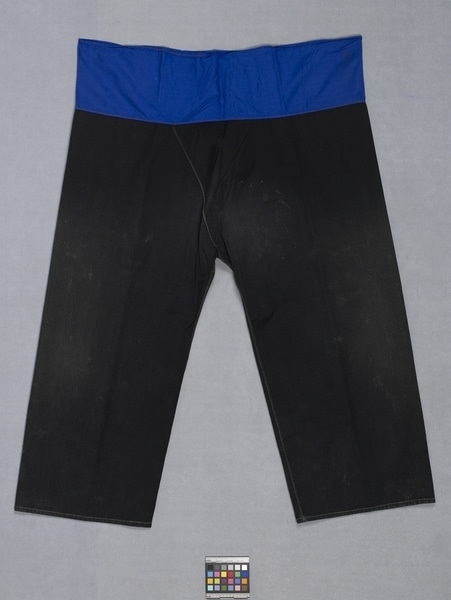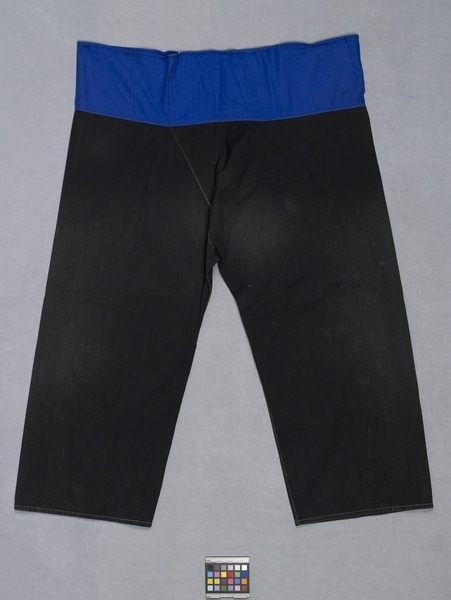Pants Item Number: Edz1070 b from the MOA: University of British Columbia


Description
Black pants (part b) with blue waistband. The pants have a wide waistband and wide straight pant legs. The black fabric has a woven stripe pattern repeating thin vertical lines, one broken and one straight, in black thread on black ground. Diagonal seam from crotch to waistband.
History Of Use
Such sets of tunics and pants, if made of cotton or hemp, were worn by women while doing farm work or cutting grass for fuel. Hakka women were known for their ability to do heavy labouring work outdoors. Their clothing was plain, decorated only with the hand-woven band worn on their aprons, head cloths, and hats. Their clothing was custom-made by tailors. The pattern of this particular cloth was called jihk fa, meaning “straight pattern”, or possibly “woven pattern”. After the mid-twentieth century the New Territories of Hong Kong began to undergo fundamental changes. The people who had been settled there before 1898, when the British colonizers claimed the area, began to give up rice agriculture and coastal fishing, turning instead to wage labour and increased employment overseas. By the end of the century, educational opportunities leading to the possibility of white-collar work also increased, together with western influences. These changes meant that objects and clothing once useful and appropriate were no longer needed and generally were discarded. Some were saved by their owners, who sometimes were willing to donate them to museums, sharing, also, their knowledge of how they were made and used. By the late 1960s, women were giving up traditional Chinese-style clothing in favour of western-influenced blouses and pants.
Iconographic Meaning
The simplicity and cotton fabric of this tunic indicate that it was for everyday wear while working.
Cultural Context
daily work; winter clothing
Narrative
This object is one of a number of old and no longer used objects collected from relatives of Mrs. Yau Chan, Shek –ying. She understood the purpose of the museum and of developing its collections, and encouraged her relatives to donate them. She also documented the objects for MOA based on her remarkable memory because, like most women her age, she had no opportunity to go to school. In 1980, Chik Wai Koon Village was about to be destroyed to make way for the development of Shatin new town, and its residents moved to new housing. They would then have to give up agriculture. This tunic was probably made by a tailor in the town of Shatin. Hakka people are one of the two original land-dwelling groups that settled the area that became the New Territories of Hong Kong. Their spoken language, and some customs, differed from those of the other original group, the Cantonese or Punti. The Cantonese arrived first and settled on the best rice-growing lands, while the Hakka began to arrive after the late 17th century and settled the more hilly lands.
Item History
- Made in Chik Wai Koon, Hong Kong, China during 1950
- Collected by Elizabeth L. Johnson during 1979
- Owned by Elizabeth L. Johnson before March 17, 1980
- Received from Elizabeth L. Johnson (Seller) and Museum of Anthropology Shop Volunteers (Funding source) on March 17, 1980
What
- Name
- Pants
- Identification Number
- Edz1070 b
- Type of Item
- pant
- Material
- cotton fibre and dye
- Part B
- height 89.0 cm, width 52.0 cm
Who
- Culture
- Chinese: Hakka
- Field Collector
- Elizabeth L. Johnson
- Previous Owner
- Elizabeth L. Johnson
- Received from
- Elizabeth L. Johnson (Seller) and Museum of Anthropology Shop Volunteers (Funding source)
Where
- Holding Institution
- MOA: University of British Columbia
- Made in
- Chik Wai Koon, Hong Kong, China
When
- Creation Date
- during 1950
- Collection Date
- during 1979
- Ownership Date
- before March 17, 1980
- Acquisition Date
- on March 17, 1980
Other
- Item Classes
- textiles
- Condition
- good
- Accession Number
- 0610/0040 b